HISTORY OF PASCO COUNTY
Dade City Churches
St. Mary’s Episcopal Church
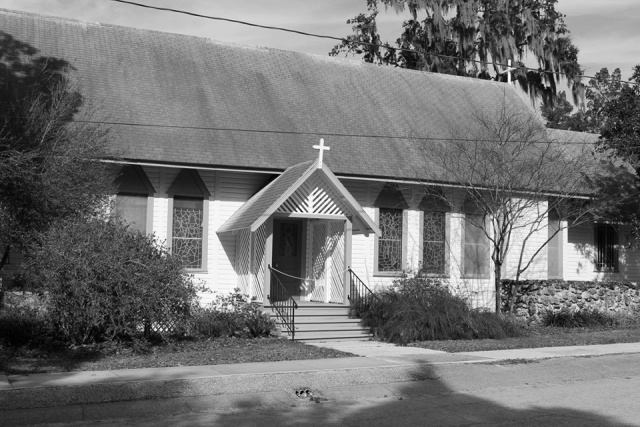
According to a web page, this church was organized on the west side of
Lake Pasadena on October 10, 1891, and constructed a sanctuary in 1892.
According to The Historic Places of Pasco County, “Organized in 1891, St. Mary’s originally served
Anglican settlers at Lake Pasadena. Its first resident priest, the Reverend James Neville-Thompson, was ordained
there in 1892. After the great freeze in 1895, the building fell into disuse while remnants of the
congregation held services at the Lock home in Dade City. In 1909 the structure was moved [to Dade City]
by mule train. The sacristy was added in 1921, the chancel in 1927, and the body of the church was
enlarged in 1975.”
An early document of the Florida Episcopal church reports, “Brooksville has lately
had the temporary services of the Rev. Justin Field, who has also given some services at Lake Buddy,
near Dade City, recently organized as a mission, with twenty communicants.” Rev. Field
preached at Brooksville for about three months in 1892, according to an article about him. Another early Florida Episcopal
church document, probably written by Rev. Field, has: “In addition to my regular work, I have
visited and officiated at Brooksville and Lake Buddy, two Sundays at each place—opening
for service a small church at Lake Buddy, and organizing the mission. In that connection I visited
the new town of Inverness, the county seat of Citrus County ….”
The following history by T. F. Zeigler, Lay Reader of St. Mary’s Church, appeared in the Dade City Banner on June 24, 1921.
The first Episcopal mission organized in Pasco county was in the early part of 1893, and a church building was erected on the farm of H. D. Harrison, just west of Lake Pasadena. Rev. Wedell, of Thonotosassa, a true man of God, was the first pastor assigned to this little mission. The church was dedicated by Bishop Weed of the Diocese of Florida. That same year the Missionary Diocese of South Florida was formed and Bishop Gray was elected bishop.
Rev. L. N. Thompson, who was ordained priest in this mission, by Bishop Gray, began his work as priest in the mission in connection with the church at Leesburg, continuing his pastorate until 1899. Then for some time Rev. Wedell again held services.
About twelve years ago St. Mary’s mission was organized in Dade City and the church property at Lake Pasadena was sold and services there discontinued.
No church building was erected in Dade City for some months after the organization of this mission, but services were held in the Presbyterian church, through the courtesy of that congregation, with Rev. Brown, the pastor. It was during Rev. Brown’s ministry that the present church building was erected, and dedicated by Bishop Gray, in 1910.
Soon after the dedication of the church Rev. Brown was called to other fields and Rev. Ticknor, pastor of the church at Clearwater, was sent to this mission in connection with his work at Clearwater, continuing services until 1915. In the latter part of 1916 Rev. Ward was assigned to this mission in connection with his pastorate at Leesburg, serving this church until June, 1920, at which time, owing to his infirmity resigned his pastorate here.
For some time no services were held, but for the last several months there has been regular services and Sunday school conducted by lay readers and competent teachers. The church people of this mission are active and earnest in the work of the church and the congregation is growing.
Many improvements to the church property and the purchase of new furniture is contemplated, and it is expected that we will have a regular pastor in charge of the services this fall.
We are reluctant to close this brief historical sketch of the church in Pasco county without some further mention of the godly men who have served it. The names of Rev. Wedell and Rev. Thompson will always be gratefully remembered by those who are familiar with the early history of the mission, and of the later pastors Rev. Ward will ever be held in kindest remembrance by this congregation.
We extend to you a cordial invitation to worship with us. Churchmen will feel at home in St. Mary’s Mission.
The following is taken from East Pasco’s Heritage (1976) and was written by Dorothy Lock and
Edward Garren.
St. Mary’s Mission Church held its first service on October 10, 1891, in its
building on the west side of Lake Pasadena, with forty souls present. Even after the
freeze of 1894-95 devastated the early citrus culture, a faithful few members
held services, using the Presbyterian Church building in Dade City. Rev. J. H. Weddell
came at intervals from Thonotosassa. The present lot on Magnolia Avenue at Eleventh Street
in Dade City was purchased in 1909 for $300. The church building from St. Mary’s Road, Pasadena,
was moved and rebuilt for $619. St. Mary’s Episcopal Church of Dade City was dedicated and consecrated
in 1910.
The sacristy was added in 1921. During the boom days, 1924-27, St. Mary’s prospered with Dade City.
The chancel was added, and new pews and lights were installed. An organ, violin, and bass viol
supported the choir. During the hard times of the thirties, the congregation held together.
By 1938 Leach Parish Hall was built of native rock, with stained glass windows from Rev.
Weddell’s abandoned church in Thonotosassa. In 1948 the first rectory was built. A Wurlitzer
organ was acquired in 1952 as a memorial to Christopher A. Lock. In 1957 St. Mary’s progressed from
a mission to full parish status.
Freeman Hall was built in 1959. This building houses many events in the life of the parish social
get-togethers, choir rehearsals, civic meetings, and parish councils. In 1973 Bamford Hall
was remodeled from the old rectory into Sunday School classrooms. In 1974 the sanctuary was greatly
enlarged. Also in 1974 the annual Arts and Crafts Fair was begun, enriching the culture of east
Pasco County, and raising funds for missions, charities, and a new pipe organ. Membership has
doubled in the past five years. The congregation of St. Mary’s is at present under the leadership
of the Very Rev. R. James Barnhardt, who is also Dean of Tampa Deanery, Southwest Florida Diocese of
the Protestant Episcopal Church.
The church is located at 37637 Magnolia Avenue in Dade City. The web site of the church is
here.
Mount Zion A. M. E. Church
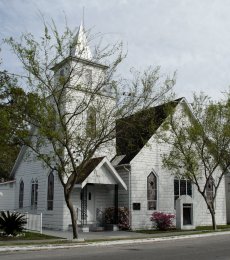
An A. M. E. church was established in the late 1800s at Lake Buddy.
The following information was provided by the church for the WPA survey: “Constituted 1889. First
services held in frame building on the same site as present T shape, gray, concrete block church
erected in 1920.”
On April 22, 1921, the Dade City Banner reported, “The African Methodist church of
Dade City has moved into their new
edifice, although the interior has not
yet been finished. The entrance and
roof of the old church alongside has
been torn off, and the building is
being extended at the rear and rebuilt as a parsonage.”
The following article was apparently written by a member of the church. Thanks to Jeff Cannon for providing it to this web site.
Mount Zion African Methodist Episcopal Church was born in
hearts and minds of a few dedicated Christians of the “A. M. E.”
persuasion during the Spanish American War, circa 1898.
Much of its history or its origin has been lost, never to be
recovered. However, through much research, personal contacts and
diligent efforts, it has been creditably established that one of the
leading spirits in the movement was Rev. Amos Thompson, an A. M. E.
Minister and resident (home owner) in the community.
It was he who led the first three Trustees, Rufus Johnson,
George Young, and B. T. Green, in purchasing the first parcel of land
that the Church owned. Today, the Church’s Annex sits on that piece of
land. The purchase was made in the year 1903. Mr. H. H. Hinley and Mrs.
L. M. Hinley were the original owners. The transaction is recorded m
the Courthouse of Pasco County, Book 22, page 5,521.
Later, two lots, adjacently located, were purchased by a new
board of Trustees: G. B. Burroughs, A. Bailey and J. R. Eagle. The
cost: $75.00 each. it is recorded in Book 25, page 110. The validity of
this statement was proven and attested to by four of the oldest living
members: Sisters Etta Howard, who became a member of the Church in
1902, Francis Harvin, Lillie Nance, and Bessie Hester.
Due to the lack of written records, we are not certain as to
who was the first pastor. However, from information gathered from many
sources, it seems factual that it was either Rev. Bell, Rev. McCrary
Hawkins or Rev. Amos Thompson.
It is interesting to note that Rev. Amos Thompson, natural
father of Mrs. Francis Harvin, was an active leader in the community
and one of the first freeholders of blacks here.
Now that the two lots were acquired, there was a new addition.
The congregation settled down to a new life of growth and development.
The Citrus industry and land had already been established in the
county, attracting many new people, and the coming of World War I,
simply accelerated the influx; hence, Mt. Zion, along with St. Paul and
St. John Baptist Churches received their share of new comers. Almost
overnight its membership doubled. This growth and expansion in
membership naturally brought on the need for more space, a new Church.
The answer to this need was the coming of the Rev. W. W. A.
Pickett as Pastor. Within no time, so to speak, the new Mt. Zion
edifice as she stands today became a reality. The new structure was
completed in 1920. The Fathers and Mothers who built it need to be
congratulated for a job well done.
Some of the laymen of the Church were: Rufus Johnson (First
superintendent of the Sunday School), George Young, G. V. Burroughs, A.
Bailey, J. R. Eagle, Ben Baisden (land owner and foreman of Lake
Buddy), Andy Johnson, Ossie Howard, B. T. Green, James Gregg, Will
Harris, Sr., Henry Hester, Angeline Baisden Curklin [Kirkland], Lillie
Nance, sis. Jones, Nancy King, Mary McBride, and Hattie Tate.
Those living today who have been members of Mt. Zion over
fifty years are: Aretha Burroughs, John Ollie Johnson, Cora Bennette,
Simeon Howard, Cora Hill, Rebecca Mitchell, and Dorothy Baker.
Bishops who have presided over the Eleventh Episcopal District
are: Bishops W. J. Gaines, J. A. Handy, B. T. Tanner, M. B. Salter, L.
J. Coppin, John Hurst, J. S. Flipper, H. Y. Tookes, A. J. Allen, J. H.
Gregg, C. A. Gibbs, D. W. Nichols, S. L. Green, W. F. Ball (former
Pastor), E. C. Hatcher, G. N. Collins, Wayman Blakely, G. D. Robinson,
H. N. Robinson, S. S. Morris, P. R. Cousin, and Frank C. Cummings
(present).
Presiding Elders who have Presided: Revs. Macklyn, A. Jackson,
W. W. A. Pickett, J. A. Brown, S. A. Ferrell, W. D. Horton, A. A.
Williams, W. D. Petters, D. A. Anderson, J. A. Roberts, G. A. Rutledge,
J. C. Williams, W. M. Roberson, Blaine, W. S. White, H. E. Green, Le
Roy Kennon, M. D. Potters.
Pastors who have served: Revs. Bell, McCrary, Amos Thompson,
D. D. Dickerson, Archie Redman, J. D. Washington, W. W. A. Pickett, J.
W. Dukes, R. D. Nimmon, J. A. Walker, sr., J. D. Jones, W. F. Ball,
Chisholm Banapart, Lavanden, H. J. Kiney, J. B. Young, S. E. James, E.
D. Dempsey, R. W. Wilson, G. J. Oates, R. H. Damer, I. D. Ford, W. L.
Byrd, A. J. Covington, J. W. Burno, Jessie Brown, T. D. Davis, W. M.
Burke, W. Jenkins, T. P. King, C. L. Cook, Al Trudell, James Crews,
James Kerney, Preston Adams, K. D. White, Jr., and Nathan Mugala
(present).
St. Rita Catholic Church (1976)
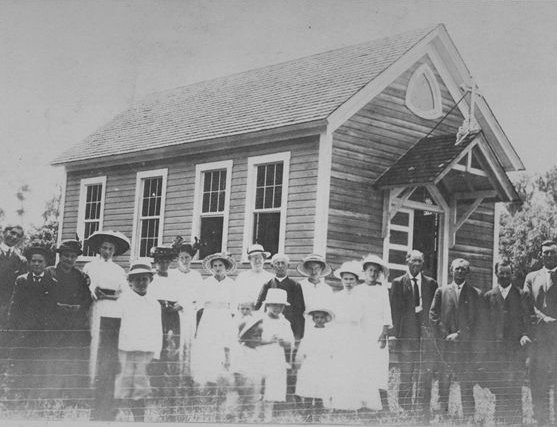
By WILLIAM FINGERHUT
This article is taken from East Pasco’s Heritage.
St. Rita Catholic Church was established as a mission in 1913. Since there were few
Catholics in Dade City at that time, the mission was largely supported by the Catholic
Extension Society and individual benefactors from the North. The Order of St. Benedict, of St.
Leo Abbey, cooperated in the founding of this church. At the request of the Rt. Rev.
Michael J. Curley, Bishop of St. Augustine, and under the direction of Abbot Charles Mohr
of St. Leo, the monks of the abbey organized missions through Hernando County, which
at that time included Pasco and Citrus counties. The priests and brothers of the abbey
have served St. Rita continuously since its beginning.
The first Mass was celebrated in St. Rita on March 4, 1913. The small mission church
was only twenty feet wide and thirty feet long. The Bishop was detained by bad roads
in his journey from St. Augustine, and failed to arrive in Dade City in time for the service.
Father Augustine Feller, of St. Leo, conducted the dedicatory Mass in his stead.
The mission progressed rapidly; within two years, in 1915, plans were made to enlarge the
church. The enlarged structure, basically the present St. Rita, was consecrated
on March 4, 1917. The bishop was present for this opening service. Soon other improvements
were made, including the installation of stained glass windows, imported from France. The
vestibule and bell tower were added, and the parish hall was completed for social activities.
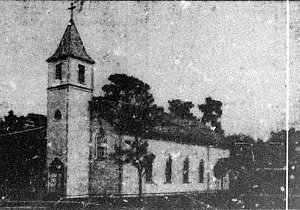 St. Rita Catholic Church in 1921
St. Rita Catholic Church in 1921
In the earliest years of the mission church, pastors resided at St. Leo Abbey and traveled
to Dade City on horseback. The following pastors have served St. Rita and its parish:
Fathers Augustine Feller, Aloysius Dressman, Francis Sadlier, Edgar Lang, John Schlicht, Ernest Schultz,
Andrew Metzger, and the present pastor, Benedict Weigand. Father Sadlier later became the second
abbot of St. Leo. Father Schultz and his successors have maintained their residence in the
church rectory on North Fourteenth Street.
The original St. Rita Church, which has served the Catholics of the Dade City area for so
many years, will not be a landmark much longer. A new church complex is now under
construction just east of the old structure. The new church, necessitated by the growth of the parish,
will have a seating capacity of 300. Included in the new complex will be a chapel for weekday
services, and facilities for social activities and religious education. The stained glass windows
and some of the statues of the old church will be installed in the new edifice, establishing
a link between the past and the future. The completion of the new St. Rita Church in 1976 will
be another milestone of Christian progress in our city.
The church web site includes a history page.
Bethel Primitive Baptist
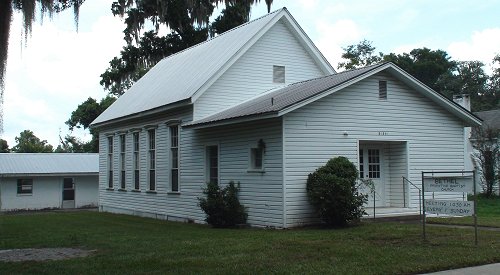 2010 photo
2010 photo
In the June 10, 1921, Dade City Banner Elder M. L.
Gilbert, one of Florida’s pioneer preachers and pastor of the
congregation for more than three decades, recounted the early years of
this
church: “The Primitive or Old School Baptist was constituted in
July 1888 some two miles north of Dade City. They are a faithful,
humble, and consecrated congregation of believers meeting for
demonstration services and worship regularly on the fourth Sunday and
Saturday
before in each month. Since 1910 they have met for worship on
Church.”
According to The Historic Places of Pasco County, this
building was originally a schoolhouse and was built about 1885. In May
of 1896, the congregation voted to buy the Indian Lake schoolhouse
and lot for $10.00. It was moved to the present location in 1910 and
subsequently expanded. An addition to the front conceals its historic
architectural character.
The following is taken from a 2005 Tampa Tribune article by Carol Jeffares Hedman.
The building at 37315 Church Ave. that is now Bethel Primitive
Baptist Church was built about 1885 as a schoolhouse in Indian Lake.
Bethel Primitive Baptist, also known as “old
school” Baptist, was formed in July 1888 about two miles north of
Dade City. For several years, the congregation met in the Blanton
schoolhouse on the fourth Sunday and Saturday before each month.
In May 1896, church members voted to buy the Indian Lake
schoolhouse and 1-acre lot for $10. It was moved to the Church Street
location in 1910 and expanded.
An addition to the front hides its historic architectural
character. The oldest portion is the one-room sanctuary that has a
front-facing gable roof and five wood, triple-hung sash windows that
represent frame vernacular architecture.
A concrete block vestibule with a lower gable roof was later
added to the front of the old schoolhouse building that was transformed
into the modest Bethel Primitive Baptist Church.
M.L. Gilbert was one of its pioneer pastors and served the
congregation for more than three decades. He also made his home on
Church Street.
Mount Zion Methodist Church (Fort Dade)
In 1872, Newton A. Carter, Wright W. Williamson, a Mr. Strickland,
and a Mr. Lyons built the Mount Zion Methodist Church in Fort Dade,
according to a 1920 article in the Dade City Banner.
On June 19, 1879, the Sunland Tribune mentions in its
Fort Dade news column Mt. Zion Methodist Church with Rev. Pander,
pastor.
A historic marker reads, “Mt. Zion Methodist Church was organized in 1871. A two-story structure, built of hand hewn
timbers and sawed rough boards on land donated by Nathan A. Carter—with the second floor
reserved for the Masonic Lodge—was completed in 1872 when the first burial was made. The
building was destroyed by a hurricane October 25, 1921.”
A 1923 newspaper article has: “Here was built one of the oldest churches in this section, Mt. Zion. It was a two-story structure, the lower floor being used for worship, while above the first Masonic lodge south of Ft. King was organized and for many years held its meeting. This historic building is now only a heap of old timber, having been abandoned years ago and later demolished by storms.”
In a 1928 newspaper article, Jasper C. Carter, secretary-treasurer of the newly-formed cemetery association wrote, “At this cemetery we have tract of a little more than six acres donated about 50 years ago by Mr. Newton Carter, father of Jasper C. Carter, for Church and Cemetery purposes, the deed being absolute with no strings about retrieving and, as there is no way of keeping the grounds in order except by voluntary gifts, we think the assessment of so low a fee as $1.00 will enable us to get a great many members….” |





